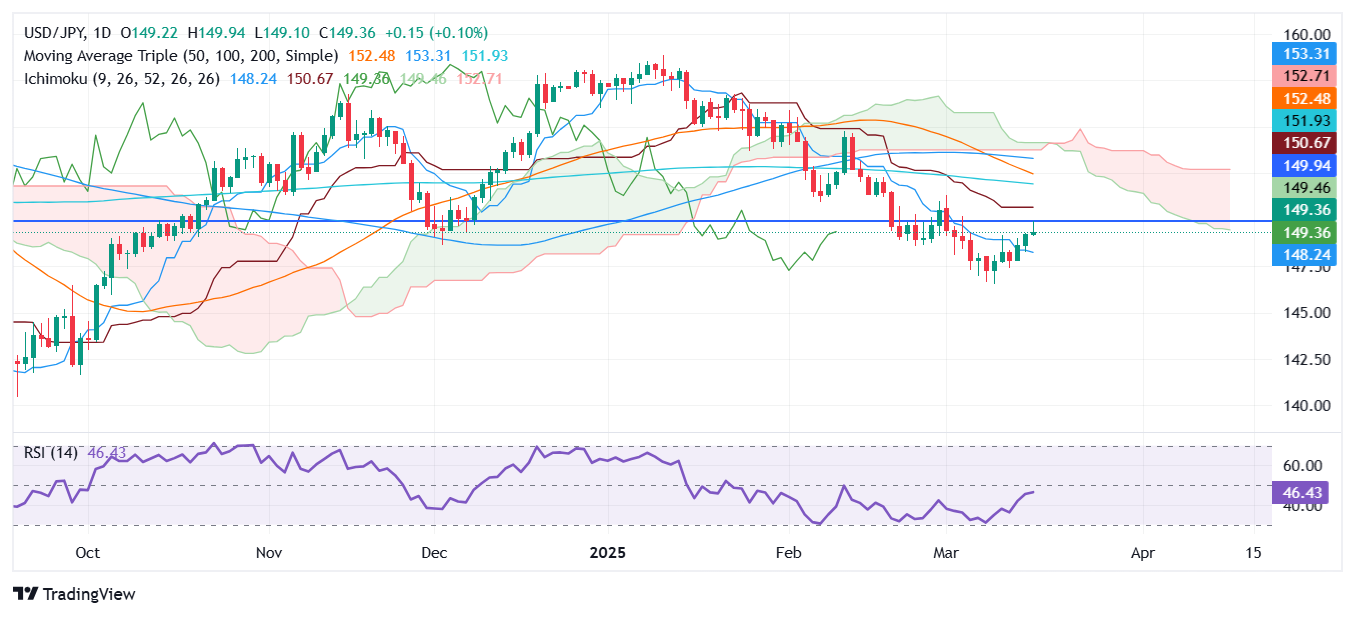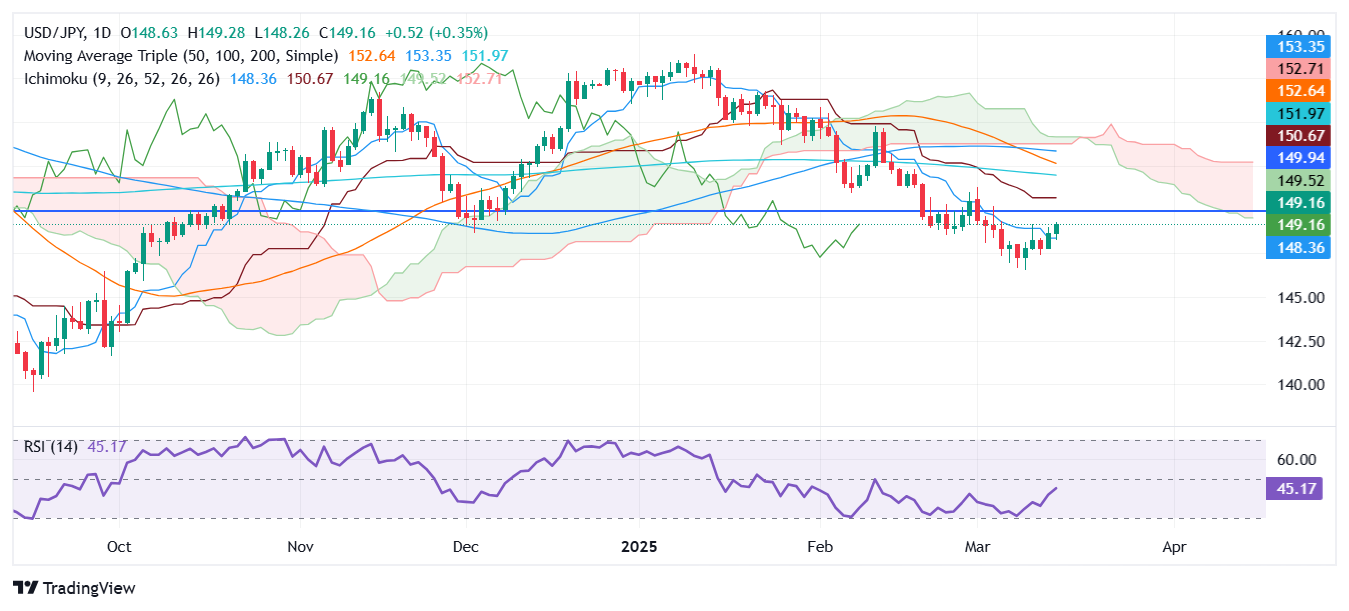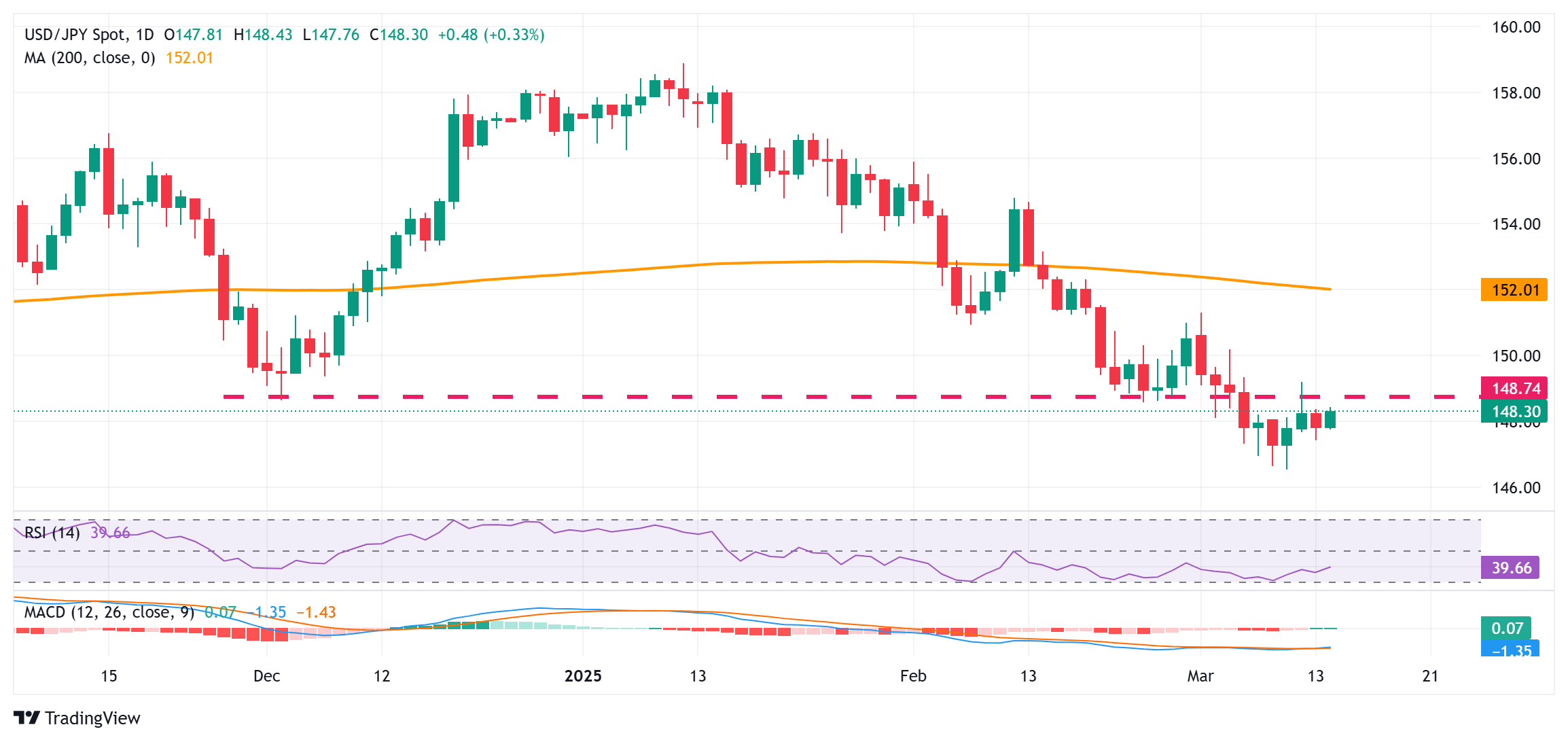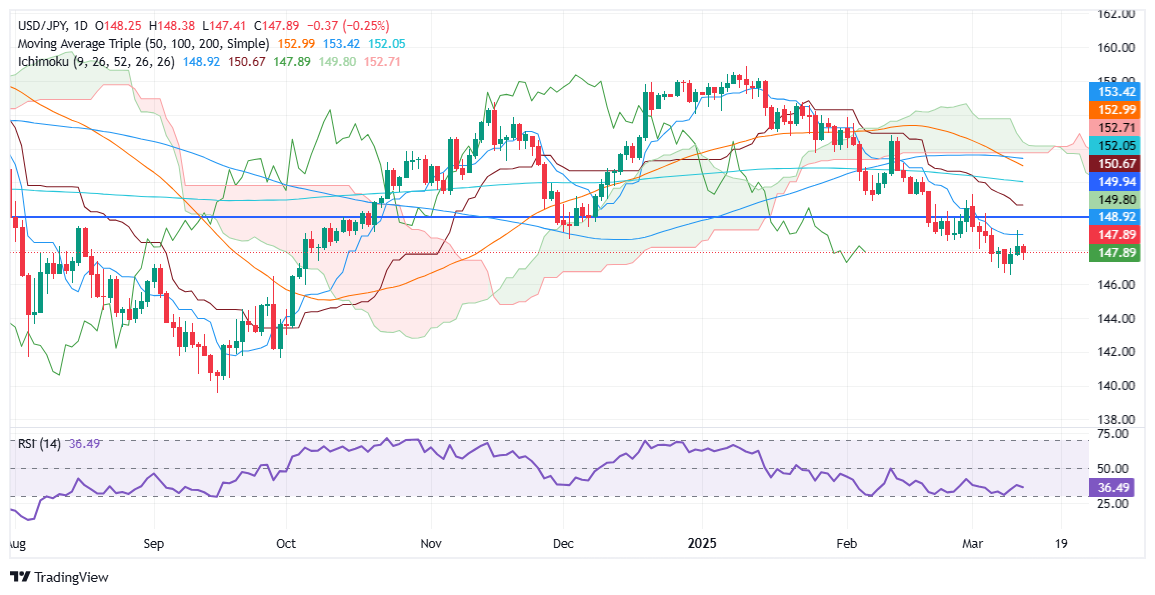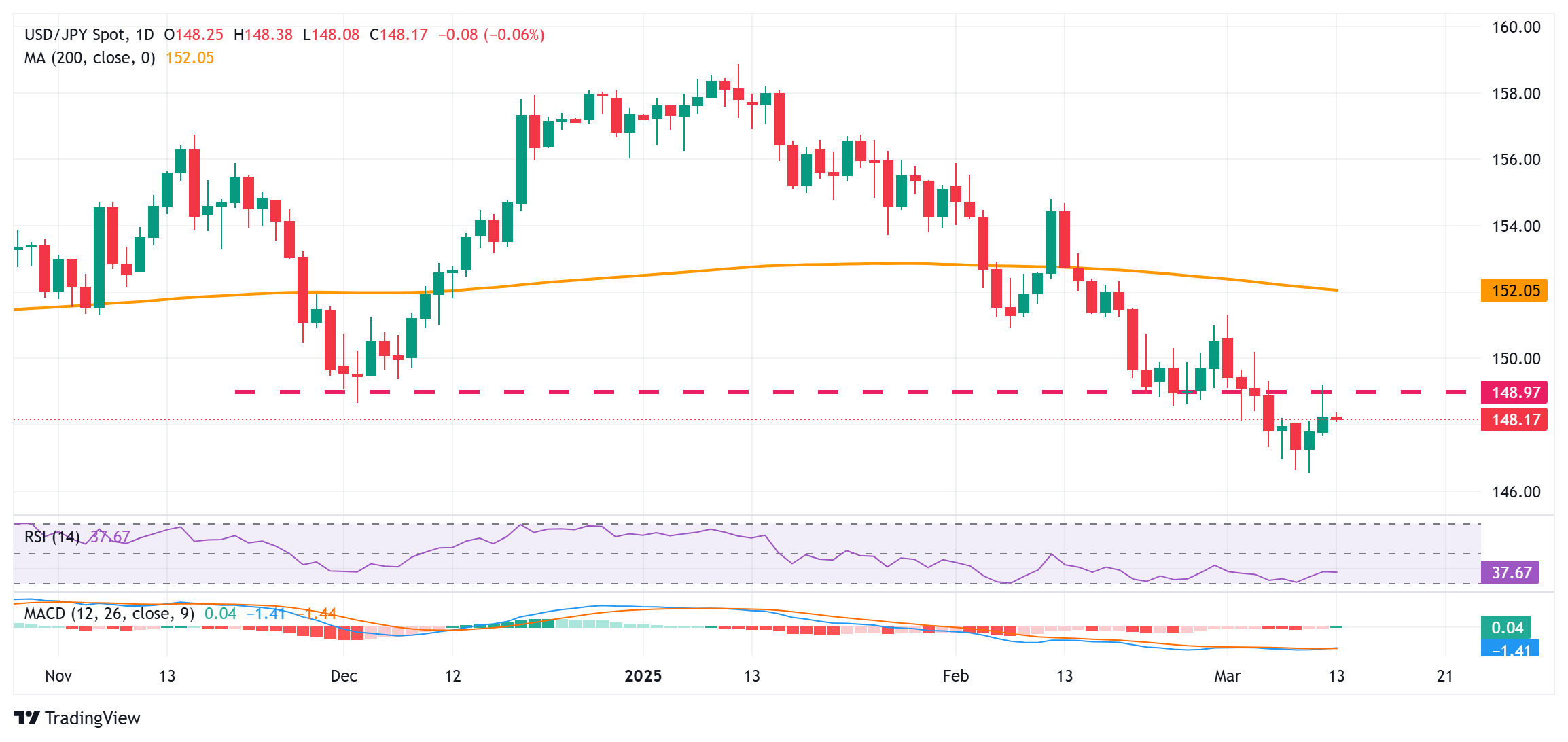- Analytics
- News and Tools
- Quotes
- Chart and quotes for USDJPY
CFD Trading Rate US Dollar vs Japanese Yen (USDJPY)
| Date | Rate | Change | |
|---|---|---|---|
| 14.05.2025 | 145.849 | -0.53% | |
| 13.05.2025 | 146.633 | -0.55% | |
| 12.05.2025 | 147.446 | -0.61% | |
| 11.05.2025 | 148.355 | 2.05% | |
| 08.05.2025 | 145.371 | -0.32% | |
| 07.05.2025 | 145.836 | 1.45% | |
| 06.05.2025 | 143.756 | 0.91% | |
| 05.05.2025 | 142.455 | -0.87% | |
| 04.05.2025 | 143.705 | -0.79% | |
| 01.05.2025 | 144.855 | -0.31% |
Related news
-
19.03.2025 18:21USD/JPY steady near 149.30 as Fed holds rates, signals caution
- USD/JPY hovers near 149.37, little changed after the Fed keeps rates unchanged but slows balance sheet reduction.
- Inflation remains “somewhat” elevated, with the Fed revising PCE and Core PCE higher, while GDP and unemployment estimates were lowered.
- Fed Governor Waller dissents, favoring an unchanged pace of balance sheet reduction, as markets digest mixed policy signals.
The USD/JPY climbs in Wednesday after the Federal Open Market Committee's (FOMC) decision to keep rates unchanged. Even though officials turned cautious on rates, the US Dollar failed to rally sharply. The pair hovers near 149.37, virtually unchanged.
Dollar struggles to rally despite Fed’s cautious stance on inflation and policy
In its monetary policy statement, the Federal Reserve acknowledged that labor market conditions remain solid but noted that inflation remains "somewhat" elevated. The FOMC reaffirmed its commitment to monitoring risks to both sides of its dual mandate and announced plans to slow the pace of balance sheet reduction starting in April.
The decision was unanimous, except for Fed Governor Christopher Waller, who preferred to keep the pace of balance sheet reduction unchanged.
In the Summary of Economic Projections (SEP), the Fed funds rate projection remained at 3.9%, unchanged from December's forecast. Officials' projections for inflation remained upwardly revised, both PCE and Core PCE figures.
The US economy is expected to slow down below the 2% threshold, an indication that the economy shifted fragile amid US President Donald Trump's trade policies.

Source: Federal Reserve
USD/JPY Rection to Fed’s decision
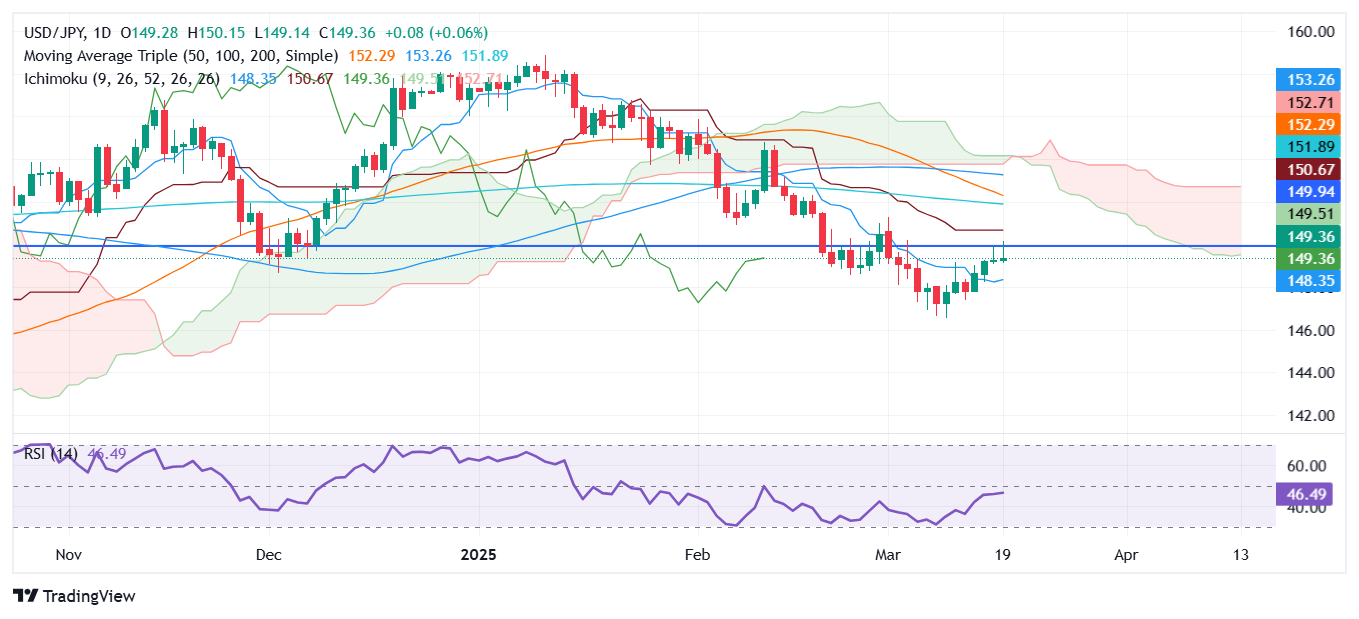
Japanese Yen PRICE Today
The table below shows the percentage change of Japanese Yen (JPY) against listed major currencies today. Japanese Yen was the strongest against the Euro.
USD EUR GBP JPY CAD AUD NZD CHF USD 0.54% 0.16% 0.04% 0.20% 0.35% 0.49% 0.24% EUR -0.54% -0.39% -0.49% -0.34% -0.18% -0.05% -0.30% GBP -0.16% 0.39% -0.10% 0.05% 0.22% 0.34% 0.08% JPY -0.04% 0.49% 0.10% 0.13% 0.30% 0.41% 0.17% CAD -0.20% 0.34% -0.05% -0.13% 0.17% 0.30% 0.02% AUD -0.35% 0.18% -0.22% -0.30% -0.17% 0.13% -0.10% NZD -0.49% 0.05% -0.34% -0.41% -0.30% -0.13% -0.26% CHF -0.24% 0.30% -0.08% -0.17% -0.02% 0.10% 0.26% The heat map shows percentage changes of major currencies against each other. The base currency is picked from the left column, while the quote currency is picked from the top row. For example, if you pick the Japanese Yen from the left column and move along the horizontal line to the US Dollar, the percentage change displayed in the box will represent JPY (base)/USD (quote).
-
19.03.2025 14:17USD/JPY revisits two-week high of 150.00 with Fed policy in focus
-
19.03.2025 10:33USD/JPY faces important resistance at the 200-MA around 152.00 – BBH
-
19.03.2025 10:28USD/JPY: Likely entered a 148.80/149.90 range trading phase – UOB Group
-
19.03.2025 09:19USD/JPY inches towards the descending trend line drawn since January – Société Générale
-
18.03.2025 22:50USD/JPY Price Forecast: Stalls below 150.00 as Yen recovers from earlier losses
-
18.03.2025 10:51USD/JPY to stay bearish on a strategic horizon – Danske Bank
-
18.03.2025 09:53USD/JPY: Major resistance at 150.30 is likely out of reach for now – UOB Group
-
17.03.2025 20:33USD/JPY Price Forecast: Rises past 149.00 as traders eye key resistance
-
17.03.2025 14:23USD/JPY rises to near 149.00 as Yen weakens, BoJ-Fed policy in focus
-
17.03.2025 14:02USD/JPY to trade at 145.00 in the end of the year – Rabobank
-
17.03.2025 10:54USD/JPY: To trade between 147.80 and 149.20 – UOB Group
-
14.03.2025 10:05USD/JPY: Expected to trade in a range between 146.50 and 149.50 – UOB Group
-
14.03.2025 02:52Japanese Yen weakens amid positive risk tone; USD/JPY bulls retake 148.00 and seek higher levels beyond
-
13.03.2025 23:22USD/JPY Price forecast: Struggles at 148.00, drops on risk aversion
-
13.03.2025 10:07USD/JPY: Likely to trade in a range between 147.60 and 148.90 – UOB Group
-
13.03.2025 02:40Japanese Yen edges higher against USD, drags USD/JPY closer to 148.00 mark
-
12.03.2025 13:54USD/JPY jumps to near 149.00 after soft US CPI data
-
12.03.2025 10:50USD/JPY: Further tactical downside may be limited for now – Danske Bank
-
12.03.2025 10:26USD/JPY: Expected to trade in a range between 146.50 and 149.50 – UOB Group
© 2000-2025. All rights reserved.
This site is managed by Teletrade D.J. LLC 2351 LLC 2022 (Euro House, Richmond Hill Road, Kingstown, VC0100, St. Vincent and the Grenadines).
The information on this website is for informational purposes only and does not constitute any investment advice.
The company does not serve or provide services to customers who are residents of the US, Canada, Iran, The Democratic People's Republic of Korea, Yemen and FATF blacklisted countries.
Making transactions on financial markets with marginal financial instruments opens up wide possibilities and allows investors who are willing to take risks to earn high profits, carrying a potentially high risk of losses at the same time. Therefore you should responsibly approach the issue of choosing the appropriate investment strategy, taking the available resources into account, before starting trading.
Use of the information: full or partial use of materials from this website must always be referenced to TeleTrade as the source of information. Use of the materials on the Internet must be accompanied by a hyperlink to teletrade.org. Automatic import of materials and information from this website is prohibited.
Please contact our PR department if you have any questions or need assistance at pr@teletrade.global.
